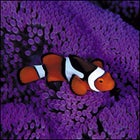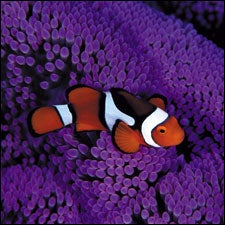Taking a class with your family or significant other can make scuba diving an even more enlightening experience. You’ve got equipment, an underwater language of hand-signals, and myriad techniques to learn, and two heads (or more) are far better than one. But more importantly, learning to dive with your family means you can help each other grasp the technical aspects of the sport, share diving experiences, and relive the spectacular scenery and thrilling sense of discovery back on dry land. While some schools cater to individuals, most offer group lessons┬Śideal for a family or a couple looking for a new adventure. Sign up for a class with your crew and you’ll never want for diving partners either.
Great Barrier Reef
 START CLOWNING AROUND: An Aussie aquatic creature in the Great Barrier Reef
START CLOWNING AROUND: An Aussie aquatic creature in the Great Barrier Reef
Don’t fall prey to the misconception that you need to head to tropical waters to learn to dive┬Śor even need access to the ocean. To get receive certification from the Professional Association of Diving Instructors (PADI), you need to undergo classroom time (either by attending class or enrolling in an at-home program), a series of closed-water dives (typically in a pool) geared toward familiarizing yourself with the equipment and procedures, and four open-water dives (held in the ocean, lake, or quarry) that test all the skills you’ve learned. The whole process can take as little as a few days or as much as months, depending on your schedule, and there are dive centers across the States that offer the program; for a list of all PADI-certified dive centers throughout the world, visit .
If you’re target=ing the West Coast, consider Craig Gillespie’s Seattle Scuba School (206.374.2937; ), part of the Scuba Schools Group, which offers scuba lessons up and down the coast as well as in Maui and Florida, and can help speed up the learning process by allowing you to do the classroom instruction via at-home CD-ROM instruction. The Seattle School also offers 10% off tuition when two or more divers sign up for a certification course (reducing the price from $299 to $270 per person). Once you’ve mastered the learning materials┬Śsuch as the effects of pressure on the body┬Śit’s time to get in a pool. These closed-water dives introduce you to the diving equipment and safety techniques, the basics in underwater breathing, how to manage the gear in the weightlessness of water, and other skill sets. Finally you’ll spend a weekend of underwater training in western Seattle, where you might be lucky enough to spot seals or kelp beds while participating in your four open-water dives. Complete the tests associated with these, and you’re deemed certified, fee to dive anywhere in the world.
If the coastal waters off Seattle less than glamorous, consider getting your classroom and closed-water dives at home, and then jumpstart your diving adventure by completing your open-water dives by enrolling in an open-water referral class at just about any PADI resort in the world. That way, you can finish up your course diving in places such as Cozumel, Thailand or Australia, allowing you to ogle a cornucopia of strange beasts like Moorish idols, nudibrachs, and Christmas tree worms in the process. Once your four dives are complete and an instructor confirms you’ve got what it takes to dive on your own, you’ll become an officially Certified PADI Open Water Diver.
If you’re looking for warmer waters and sunnier skies from the start, head to what the readers of Scuba Diving Magazine voted their Top Beginner Diving Destination: the Florida Keys town of Islamorada. Here you’ll find Mike and Marcia, a husband-and-wife team of instructors and owners of Key Dives at Bud & Mary’s Marina (800.344.7352; ). This popular diving school offers Open Water Diving Certification for $450, or a cheaper Discover Scuba Diving Course for just $135. The latter option will allow you to experience all of the scuba techniques, as well as dive among the largest living ocean reef in the United States┬Śadjacent to Key Dives’ dive shop┬Śbefore the one-day class is done. It won’t certify you as an Open Water Diver, but it’s a great intro for those who might be reticent about the diving experience. And for kids already game to dive in, a PADI Junior Open Water Diving Course is available for those ages ten to 14. Key Dives offers open-water referral clases for $250.
Then there’s Hawaii. Maui’s Island Scuba and Surf School (888.606.4608; ) teaches complete open-water diving certification courses every day. But to maximize your time in Hawaii, do your classroom and closed-water lessons at home to jump ahead to the school’s referral program. That class takes just two days and is priced at $249. Once you have your certificate in hand, join Island and Surf School on dives for $82, or on trips to the renowned dive sites off the coast of Lana’i. Better yet, explore the protected and extinct volcano of Molokini on a 65-foot catamaran. These half-day dive trips begin at just $127 with scuba equipment, continental breakfast, deli lunch, and all the Jimmy Buffet music you can handle. Divers will swim among coral gardens, lava tubes, colorful reef fish, and green sea turtles, a protected reptile in U.S. waters.
┬ľAmy A. Clark
To learn more on how to receive your diving certification, visit “,” a guide to certification from The Away Network.
To learn more about the world’s many dive sites, browse excerpts from the Lonely Planet’s .

